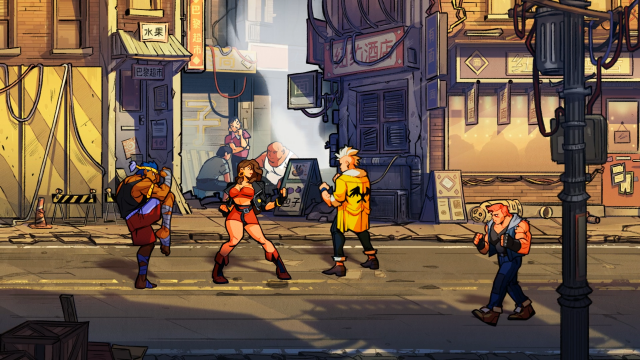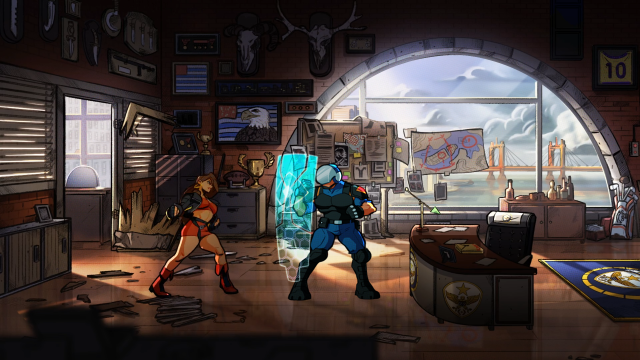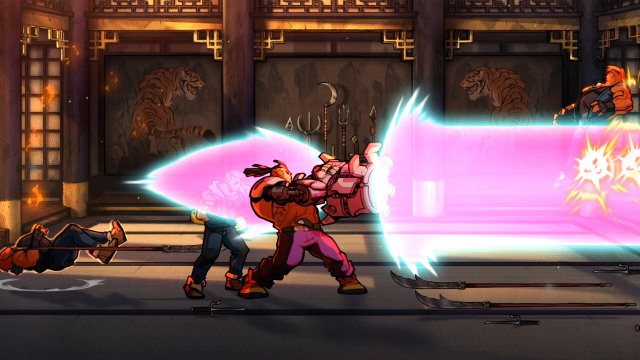Brawlers are officially cool again; inspired combat introduces new mechanics to classic beat 'em up gameplay that will be an inspiration to other developers for years to come; killer soundtrack; beautiful art direction; performance is steady and strong; huge cast
Movement speed might frustrate some players; can be tough even on easier which might turn away inexperienced and younger players; enemy AI can get phased by holes in the ground
Warning: Some minor spoilers pertaining to the roster. It’s all been previously revealed in marketing materials, but if you don’t want to know who’s in the game, please read this review later on.
Streets of Rage 4 is a brilliant evolution of the brawler gameplay from the first trilogy of Rage games on Sega Genesis. Beat ’em ups by their nature aren’t typically very deep. Usually players move on a 2D plane traveling left to right and beat the lights out of every enemy that crosses their path. Rinse and repeat. The best of these games offer a variety of combo and special attacks, as well as other moves and mechanics to help keep combat spicy and engaging. That said, more often than not brawlers don’t do much to advance the genre. For years during the ’90s there was a glut of “Final Fight clones,” as they were often called, and the culprits were frequently licensed games with superheroes, cartoon characters, and so on.
Thankfully, developers Dotemu, Lizardcube, and Guard Crush Games have avoided the pratfalls of numerous mediocre beat ’em ups with the release of Streets of Rage 4. 2D gaming has been experiencing a renaissance of sorts for the past 10 to 15 years with everyone from Capcom to small indie studios churning out a steady stream of platformers, run and gunners, and other retro-themed releases. Yet, one genre that has been notable for its absence has been the brawler. The glory days of taking to the streets to punch crooks and drug dealers in the face have faded into obscurity in the world of video games. The blame rests on those shoddy Final Fight clones I mentioned above, but it’s taken far too long for developers to land upon the notion that when done right, brawlers are as fun and rewarding as any other classic video game genre.
Although it likely might have been tempting to stick right to the formula of the first Streets of Rage trio, Dotemu and company instead chose to infuse that recipe with something new. The basics are here with a selection of fighters wielding special moves. The difference lies in the broadening of the fighting mechanics. Grabbing weapons and items to use in a fight is par for the course in brawlers, but in Streets of Rage 4 players have the ability to throw them at enemies and then catch them once the objects ricochet back. This provides for some really kinetic exchanges with foes where punches are tossed alongside bats and bottles, turning fights into swirls of melee and ranged combat. Enemies will even join in the fun and throw stuff at the player, too, which ratchets up the complexity of these skirmishes.
Another addition to the fighting mechanics involves the cast’s special moves. In past Streets of Rage games, players had the chance to expend part of a fighter’s health in order to add extra power to an attack. In my experience, I tend to avoid moves with this sort of splash damage because I don’t think the benefit of the additional strength outweighs the negative of losing some of my life bar. In Streets of Rage 4, this convention has been altered by introducing provisional damage into the mix. Provisional, or temporary, damage is generally utilized in fighting games. Players see their health bar diminish, but part of the energy is recovered as time goes by or other conditions are met. In Streets of Rage 4, special attacks will deplete the character’s energy, but a risk-reward opportunity instantly presents itself. Land some more punches and that health refills—get hit and it goes away.
These tweaks might sound innocuous but they make a world of difference to the overall gameplay experience. Being able to volley items and deliver massive damage in conjunction with the regular suite of punches and kicks allows for some wicked combo possibilities. What’s more, each character has a unique super special move that’s activated by picking up star tokens off the ground. As a resource super specials are quite limited, but when held onto for the most opportune moment to strike, they can be indispensable. This is especially the case when taking on a huge crowd or a sadistically tricky boss fight. Combined, this menagerie of carnage has become one of my favorite repertoires of fight moves that I’ve ever encountered in a brawler.
As a sequel, Streets of Rage 4 feels like it takes from the best bits of the first three games that came before it. The settings are more grounded and urban like the first Streets of Rage, while the combat rests in a happy middle ground right between the second and third installments. The feedback in Streets of Rage 4 is very reminiscent of Streets of Rage 2, along with battle tempo, but the combo system and special moves are unmistakable trappings from Streets of Rage 3. Character movement speed will doubtlessly prove polarizing to some players, as the majority of fighters can’t run or dash. However, there are unlockable characters that make the pace of movement more varied, so there should be at least one or two fighters to please a myriad of player preferences. It’s unfortunate that the whole roster isn’t available from the outset, but even the stock four (plus Adam partway through the campaign) have enough variance to keep the majority of players happy.
The cast is a mix of returning favorites and new faces with ties to the past. As in previous games, the characters and enemies alike are diverse, well designed, and have different strengths and weaknesses. Blaze, Axel, and Adam are reminiscent of their former incarnations, while newcomers Cherry and Floyd are fresh takes on characters Skate, Max “Thunder” Hatchett, and Dr. Gilbert Zan. There’s a sense of legacy for these characters, too, with Cherry being the daughter of Adam and Floyd as Zan’s protege. As players add to the running score counter that tracks points earned between modes and rounds, new fighters are unlocked. The entirety of the roster from each prior Streets of Rage game is in Streets of Rage 4. They’re represented pixel-for-pixel as reproductions of the original sprites from each game. What’s more, they also retain their move sets from those games.
It’s an incredible piece of fan service that is only part of this undeniable love letter to the franchise and brawlers in general. From the music to its screen filters, Streets of Rage 4 pays a lot of respect to what has come before. That said, don’t let lazy talk of “nostalgia” sway anyone into thinking that this isn’t a whole new experience. Streets of Rage 4 has positioned brawlers to once again be en vogue in the video game industry. There have been a fair share of action RPGs that mix brawling with experience points and gear slots, but it’s almost as though developers feel obliged to include those trappings for fear of being labeled basic or uninspired. Streets of Rage 4 has made it cool to just crack heads again.
There are few games as gorgeous as Streets of Rage 4 is. The game looks like a comic book come to life. Hand drawn, the backgrounds and character animations all compliment the gritty world of Streets of Rage. The soundtrack is similarly impressive, with Olivier Deriviere joined by Yuzo Koshiro and Motohiro Kawashima delivering the bulk of the score. It’s an eclectic blend of techno beats and guitar riffs, punk and jazz, and all of it perfectly meshes with the on-screen action. There’s even an option to listen to the music from the Genesis trio while playing. Throw in an art gallery, multiplayer (both online and off), and a bunch of extras, and Streets of Rage 4 is a truly complete package.
Performance is another area that is rock solid. I never experienced any slowdown during my time playing the game. The only noteworthy gripe would be that enemy AI can often become perplexed by holes in the ground or obstructions in its path. It was a regular sight to see foes pacing in place rather than going around to come and fight me. It’s nothing terrible, but it can disrupt the flow of combat—not to mention look downright silly. It’s the only technical blemish I can find in a game that is otherwise nearly perfect. Hopefully a patch will be forthcoming to correct this small nuisance.
Multiple game modes help to keep the player coming back for more. Story mode is where the narrative unfolds, which is told in gorgeous cinematic stills featuring the same art style as the rest of the game. Arcade mode tasks players with beating the story line using no continues; die and it’s back to the beginning. Boss Rush and Battle mode round things out, and all of it (with the exception of Arcade mode) can be played at different difficulty levels. It’s always a challenge to bring a franchise out of dormancy after so long, especially one as lauded as Streets of Rage. What Dotemu and partners have done is such a masterful expansion and resuscitation that I’d be willing to say that the series is officially theirs, and that they have collectively made brawlers a part of the conversation in game development for the first time in years. Bravo. Buy this game.
Nintendojo was provided a copy of this game for review by a third party, though that does not affect our recommendation. For every review, Nintendojo uses a standard criteria.




 ShareThis
ShareThis








